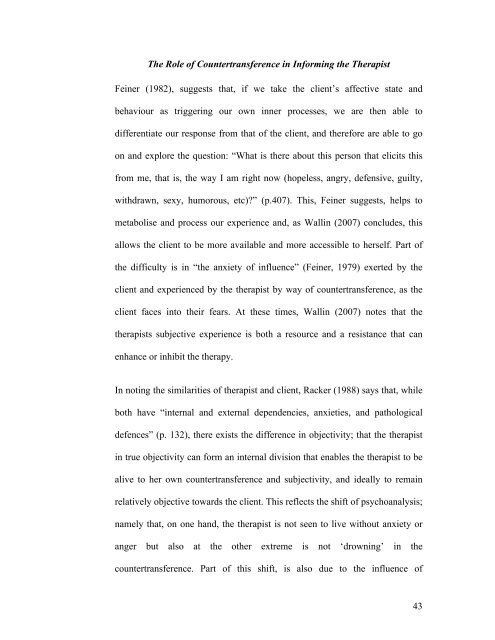“Ghosts at the banquet” - Scholarly Commons Home
“Ghosts at the banquet” - Scholarly Commons Home
“Ghosts at the banquet” - Scholarly Commons Home
You also want an ePaper? Increase the reach of your titles
YUMPU automatically turns print PDFs into web optimized ePapers that Google loves.
The Role of Countertransference in Informing <strong>the</strong> Therapist<br />
Feiner (1982), suggests th<strong>at</strong>, if we take <strong>the</strong> client’s affective st<strong>at</strong>e and<br />
behaviour as triggering our own inner processes, we are <strong>the</strong>n able to<br />
differenti<strong>at</strong>e our response from th<strong>at</strong> of <strong>the</strong> client, and <strong>the</strong>refore are able to go<br />
on and explore <strong>the</strong> question: “Wh<strong>at</strong> is <strong>the</strong>re about this person th<strong>at</strong> elicits this<br />
from me, th<strong>at</strong> is, <strong>the</strong> way I am right now (hopeless, angry, defensive, guilty,<br />
withdrawn, sexy, humorous, etc)?” (p.407). This, Feiner suggests, helps to<br />
metabolise and process our experience and, as Wallin (2007) concludes, this<br />
allows <strong>the</strong> client to be more available and more accessible to herself. Part of<br />
<strong>the</strong> difficulty is in “<strong>the</strong> anxiety of influence” (Feiner, 1979) exerted by <strong>the</strong><br />
client and experienced by <strong>the</strong> <strong>the</strong>rapist by way of countertransference, as <strong>the</strong><br />
client faces into <strong>the</strong>ir fears. At <strong>the</strong>se times, Wallin (2007) notes th<strong>at</strong> <strong>the</strong><br />
<strong>the</strong>rapists subjective experience is both a resource and a resistance th<strong>at</strong> can<br />
enhance or inhibit <strong>the</strong> <strong>the</strong>rapy.<br />
In noting <strong>the</strong> similarities of <strong>the</strong>rapist and client, Racker (1988) says th<strong>at</strong>, while<br />
both have “internal and external dependencies, anxieties, and p<strong>at</strong>hological<br />
defences” (p. 132), <strong>the</strong>re exists <strong>the</strong> difference in objectivity; th<strong>at</strong> <strong>the</strong> <strong>the</strong>rapist<br />
in true objectivity can form an internal division th<strong>at</strong> enables <strong>the</strong> <strong>the</strong>rapist to be<br />
alive to her own countertransference and subjectivity, and ideally to remain<br />
rel<strong>at</strong>ively objective towards <strong>the</strong> client. This reflects <strong>the</strong> shift of psychoanalysis;<br />
namely th<strong>at</strong>, on one hand, <strong>the</strong> <strong>the</strong>rapist is not seen to live without anxiety or<br />
anger but also <strong>at</strong> <strong>the</strong> o<strong>the</strong>r extreme is not ‘drowning’ in <strong>the</strong><br />
countertransference. Part of this shift, is also due to <strong>the</strong> influence of<br />
43
















